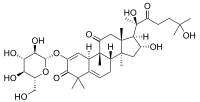Bryoamaride
 | |
| Names | |
|---|---|
| IUPAC name
(9R,10R,13R,14S,16R,17R)-17-(1,5-Dihydroxy-1,5-dimethyl-2-oxo-hexyl)-16-hydroxy-4,4,9,13,14-pentamethyl-2-[(2S,3R,4S,5S,6R)-3,4,5-trihydroxy-6-(hydroxymethyl)tetrahydropyran-2-yl]oxy-8,10,12,15,16,17-hexahydro-7H-cyclopenta[a]phenanthrene-3,11-dione | |
| Other names
Cucurbitacin L 2-O-β-D-glucopyranoside | |
| Identifiers | |
3D model (JSmol) |
|
| ChemSpider | |
PubChem CID |
|
| |
| |
| Properties | |
| C36H54O12 | |
| Molar mass | 678.82 g·mol−1 |
Except where otherwise noted, data are given for materials in their standard state (at 25 °C [77 °F], 100 kPa). | |
| Infobox references | |
Bryoamaride is a chemical compound isolated from certain plants, notably Bryonia dioica. It can be seen as a derivative of the triterpene hydrocarbon cucurbitane (C
30H
54), more specifically from cucurbitacin L or 23,24-dihydrocucurbitacin I.[1]:65
The derivative 25-O-acetylbryoamaride is found in Trichosanthes tricuspidata.[1]:66
References
- 1 2 Jian Chao Chen, Ming Hua Chiu, Rui Lin Nie, Geoffrey A. Cordell and Samuel X. Qiu (2005), "Cucurbitacins and cucurbitane glycosides: structures and biological activities" Natural Product Reports, volume 22, pages 386-399 doi:10.1039/B418841C
This article is issued from
Wikipedia.
The text is licensed under Creative Commons - Attribution - Sharealike.
Additional terms may apply for the media files.